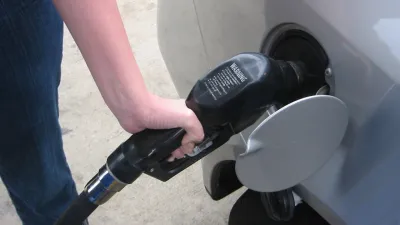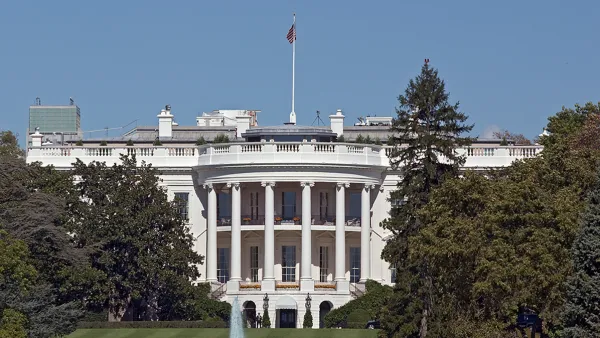On Tuesday, the Trump administration anticipates unraveling two signature Obama environmental regulations: fuel efficiency standards for model year 2022-2025 light-duty vehicles and beginning the undoing of the Clean Power Plan.

Last January, when Donald Trump was still president-elect, the U.S. Environmental Protection Agency completed their required midterm review, an evaluation (pdf) of the "Appropriateness of the Model Year 2022-2025 Light-Duty Vehicle Greenhouse Gas Emissions Standards." Six months earlier, E.P.A. had issued a draft report concluding that the auto industry would come very close to meeting the rule, finalized in October 2012, of 54.5 miles per gallon by year 2025.
E.P.A.'s final determination was to make no changes to the standard, which pleased environmentalists but disappointed auto manufacturers.
Enter President Trump and his industry-friendly cabinet, and the auto industry seized an opportunity after the Feb. 17 confirmation of Scott Pruitt as E.P.A. administrator to reverse the determination made by the prior administrator, Gina McCarthy. On account of the fact that the E.P.A. "did not jointly release its plan...with the Transportation Department," it left "a legal loophole for the Trump Administration to take advantage of," writes Coral Davenport, climate and energy reporter for The New York Times.
Three agencies are involved in determining fuel efficiency standards:
- The E.P.A., which uses the term greenhouse gas emissions standards [Planetizen tag: fuel efficiency standards.]
- The Department of Transportation, specifically by the National Highway Traffic Safety Administration which uses uses the term, Corporate Average Fuel Economy (CAFE) standards.
- The California Air Resources Board, which received an E.P.A. waiver by the Obama administration in 2009 after being denied by President George W. Bush, allowing them to set their own standards, though Davenport adds the "E.P.A. will also begin legal proceedings to revoke" the waiver. That won't be easy, according to S. William Becker, the executive director of the National Association of Clean Air Agencies.
He also predicted that “if this administration goes after the California waiver, there will be an all-out brawl between Trump and California and the other states that will defend its program.”
No doubt Pruitt, Transportation Secretary Elaine Chao, and President Trump were sympathetic to the Auto Alliance's letter (pdf) of Feb. 21 which made the following claims about the burdensome regulation:
Even today, no conventional vehicle today meets that [54.5 mpg] target, and conventional vehicles comprise 96.5% of the new light-duty vehicle fleet. Only some non-conventional vehicles (i.e., hybrid, plug-in electric, and fuel cell vehicles) which comprise fewer than 3.5% of today's new vehicles, currently can do so.
Even under EPA's optimistic estimates, the automotive industry will have to spend a staggering $200 billion between 2012 and 2025 to comply, making these standards many times more expensive than the Clean Power Plan.
Last month, President Trump announced his attention to rescind President Obama's Clean Power Plan, already purged from White House website, which requires a 32 percent cut in carbon emissions from existing power plants by 2030 on 2005 levels. The rule has been placed on suspension after a 5-4 ruling by the Supreme Court in February 2016. Davenport explains what Pruitt will have to do to dismantle that rule and the fuel efficiency standards:
He will have to legally withdraw the existing rule and propose a new rule to replace it, a process that could take up to two years and is expected to be fraught with legal challenges and delays along the way.
The effort to undo the tailpipe standards will be much more legally simple. After withdrawing the Obama administration’s requirement for model years 2022 through 2025, the Trump administration will have a year to put forth an alternative set of efficiency standards, people familiar with the matter said.
Effect on greenhouse gas emissions
Redoing those two signature rules in the Obama Climate Initiative may have a dramatic effect on the increasing greenhouse gas emissions, as the 2014 pie chart shows:

As Planetizen editor James Brasuell posted last June, the transportation sector supplanted the power sector as the top source of carbon emissions, though that may have more to do with heavy trucks than light-duty vehicles. In addition, due largely to cheap gas, Americans set a new record last year in vehicle miles driven, and last year bought more light trucks, including sport utility vehicles, than passenger cars which are generally more fuel efficient.
FULL STORY: Trump to Undo Vehicle Rules That Curb Global Warming

National Parks Layoffs Will Cause Communities to Lose Billions
Thousands of essential park workers were laid off this week, just before the busy spring break season.

Retro-silient?: America’s First “Eco-burb,” The Woodlands Turns 50
A master-planned community north of Houston offers lessons on green infrastructure and resilient design, but falls short of its founder’s lofty affordability and walkability goals.

Delivering for America Plan Will Downgrade Mail Service in at Least 49.5 Percent of Zip Codes
Republican and Democrat lawmakers criticize the plan for its disproportionate negative impact on rural communities.

Test News Post 1
This is a summary

Test News Headline 46
Test for the image on the front page.

Balancing Bombs and Butterflies: How the National Guard Protects a Rare Species
The National Guard at Fort Indiantown Gap uses GIS technology and land management strategies to balance military training with conservation efforts, ensuring the survival of the rare eastern regal fritillary butterfly.
Urban Design for Planners 1: Software Tools
This six-course series explores essential urban design concepts using open source software and equips planners with the tools they need to participate fully in the urban design process.
Planning for Universal Design
Learn the tools for implementing Universal Design in planning regulations.
EMC Planning Group, Inc.
Planetizen
Planetizen
Mpact (formerly Rail~Volution)
Great Falls Development Authority, Inc.
HUDs Office of Policy Development and Research
NYU Wagner Graduate School of Public Service




























